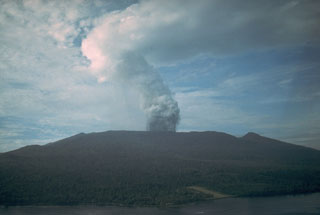Report on Karkar (Papua New Guinea) — November 1978
Scientific Event Alert Network Bulletin, vol. 3, no. 11 (November 1978)
Managing Editor: David Squires.
Karkar (Papua New Guinea) Seismicity declines slightly; incandescence and strong vapor emission persist
Please cite this report as:
Global Volcanism Program, 1978. Report on Karkar (Papua New Guinea) (Squires, D., ed.). Scientific Event Alert Network Bulletin, 3:11. Smithsonian Institution. https://doi.org/10.5479/si.GVP.SEAN197811-251030
Karkar
Papua New Guinea
4.647°S, 145.976°E; summit elev. 1839 m
All times are local (unless otherwise noted)
Strong seismic activity persisted through November. Strongly marked periodic bands on the seismograph records were again evident between the lst and 17th. Tremor was felt at the observation post, 2 km from the volcano, throughout the month. Seismicity began to increase on 10 July (03:9-10), peaked 23 and 24 October, then remained steady or declined slightly 29 October-29 November. Incandescence (first observed 27 September) and strong vapor emission also continued through November.
Geological Summary. Karkar is a 19 x 25 km forest-covered island that is truncated by two nested summit calderas. The 5.5 km outer caldera was formed during one or more eruptions, the last of which occurred 9,000 years ago. The steep-walled 300-m-deep, 3.2 km diameter, inner caldera was formed sometime between 1,500 and 800 years ago. Cones are present on the N and S flanks of this basaltic-to-andesitic volcano; a linear array of small cones extends from the northern rim of the outer caldera nearly to the coast. Recorded eruptions date back to 1643 from Bagiai, a pyroclastic cone constructed within the inner caldera, the floor of which is covered by young, mostly unvegetated andesitic lava flows.
Information Contacts: R. Cooke, RVO.

